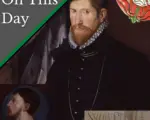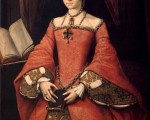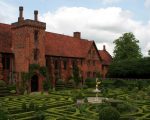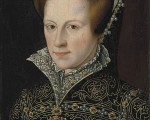
On this day in Tudor history, 22nd January, war was declared, a Lord Protector was beheaded, Wyatt’s Rebellion was planned, and Francis Bacon, a lord chancellor and famous philosopher, author and scientist, was born…
[Read More...]
On this day in Tudor history, 22nd January, war was declared, a Lord Protector was beheaded, Wyatt’s Rebellion was planned, and Francis Bacon, a lord chancellor and famous philosopher, author and scientist, was born…
[Read More...]
What happens when a jury doesn’t find an alleged traitor guilty and, instead, acquits him? Well, the jurors get arrested and thrown into prison, of course!
I explain exactly what happened on this day in Tudor history, 17th April 1554, in the case of Sir Nicholas Throckmorton. I also give details on how the jurors finally got released and what happened to Throckmorton.
[Read More...]
On this day in Tudor history, 11th April 1554, in the reign of the Catholic Queen Mary I, Sir Thomas Wyatt the Younger, son of poet and diplomat Sir Thomas Wyatt the Elder, was beheaded on Tower Hill after being found guilty of high treason.
Wyatt had led a rebellion which sought to depose the queen and to replace her with her half-sister Elizabeth, but he refused to implicate Elizabeth in the plot. He went to his death asserting her innocence.
Find out more about what happened and hear his final speech…
[Read More...]
On this day in history, 30th January 1606, Gunpowder plotters Everard Digby, Robert Wintour, John Grant and Thomas Bates were executed for treason at St Paul’s Churchyard.
Find out how they came to this end and hear a contemporary account of their executions in this talk…
[Read More...]
On this day in Tudor history, 17 April 1554, in the reign of Queen Mary I, celebrations for the acquittal of a Tudor courtier led to the head of his fellow rebel being stolen. It was the head of Sir Thomas Wyatt the Younger.
Find out what happened
[Read More...]
On this day in Tudor history, 22nd January 1554, Thomas Wyatt the Younger met with fellow conspirators at his home of Allington Castle in Kent. The purpose of their meeting was to make final plans for their uprising against Queen Mary I and her decision to marry Philip of Spain.
This rebellion would come to be known as Wyatt’s Rebellion, although the leader at the start appears to have been Sir James Croft.
Find out all about Wyatt’s Rebellion and what happened in this talk.
[Read More...]
On this day in Tudor history, 11th April 1554, in the reign of the Catholic Queen Mary I, Sir Thomas Wyatt the Younger, son of poet and diplomat Sir Thomas Wyatt the Elder, was beheaded on Tower Hill after being found guilty of high treason.
Wyatt had led a rebellion which sought to depose the queen and to replace her with her half-sister Elizabeth, but he refused to implicate Elizabeth in the plot. He went to his death asserting her innocence.
Find out more about what happened and hear his final speech in today’s video.
[Read More...]
In today’s “on this day in Tudor history”, we go back to 1554, where trouble was brewing for both Mary I and her half-sister, Elizabeth.
[Read More...]
On this day in history, 11th April 1554, Sir Thomas Wyatt the Younger was beheaded and then his body quartered for treason, for leading Wyatt’s Rebellion against Queen Mary I.
Wyatt had already shown his opposition to Mary when he supported Lady Jane Grey’s claim to the throne after the death of Edward VI – he escaped punishment that time – but he felt compelled to act when he found out about Mary I’s plans to marry King Philip II of Spain.
[Read More...]
On the 30th January 1554, Thomas Wyatt the Younger, son of poet and diplomat Sir Thomas Wyatt, and his fellow rebels besieged Cooling Castle, near Rochester in Kent.
[Read More...]

On the 11th April 1554, Sir Thomas Wyatt the younger was beheaded and then his body quartered for treason, for leading Wyatt’s Rebellion against Queen Mary I.
Wyatt had already shown his opposition to Mary when he supported Lady Jane Grey’s claim to the throne after the death of Edward VI – he escaped punishment that time – but he felt compelled to act when he found out about Mary I’s plans to marry King Philip II of Spain.
The plan was to have a series of uprisings in the South, Southwest, Welsh Marches and Midlands, and then a march on London to overthrow the government, block the Spanish marriage, dethrone Mary and replace her with her Protestant half-sister, Elizabeth, who would marry Edward Courtenay. Unfortunately for Wyatt, other rebel leaders like the Duke of Suffolk (Lady Jane Grey’s father) and the ill-fated Lady Jane Grey (who had nothing to do with the revolt), the plan failed.

On this day in 1554, Queen Mary I gave a rousing speech at the Guildhall to rally Londoners to her cause and to oppose Wyatt’s rebellion. Contemporary John Proctor recorded that Mary “did wonderfullye inamour the heartes of the hearers as it was a world to heare with what shoutes they exalted the honour and magnanimitie of Quene Mary”.
Mary denounced Thomas Wyatt the Youngerand his rebels, but said that she had sent two of her privy council to “the traitour Wyat, desirous rather to quiete thys tumulte by mercie, then by iustice [justice] of the sworde to vanquishe.” She defended her plan to marry Philip of Spain as being beneficial to England, and affirmed:
[Read More...]
On 22nd January 1554, Thomas Wyatt the Younger met with fellow conspirators at his home of Allington Castle in Kent to make final plans for their uprising against Mary I and her decision to marry Philip of Spain. This rebellion would become known as Wyatt’s Rebellion.
[Read More...]